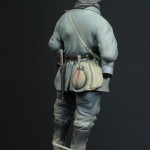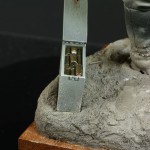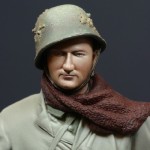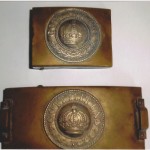







David Lane Paints – See the step-by-step of how David paints this figure:

German Veteran NCO, Western Front 1917/18
- Scale / Maßstab: 1/16th (120mm)
- Approx. height of figure: 113mm
- Material: Resin (figure), Model Plaster (base) / Resin (Fugur), Modell-Gips (Sockel – synethetische, kunststoffveredelte Gießmasse)
- Parts / Teile: 30
- Infosheet / Infoblatt: English
- Code / Artikel-Nr.: 27AH
- Attention: Not a toy. Model kit or model making accessories – not suitable for children under 14 years of age. / Achtung: Kein Spielzeug. Modellbauzubehör – nicht für Kinder unter 14 Jahren geeignet
GPSR Data / Angaben
- Manufacturer / Hersteller: Jon Smith Modellbau
- Responsible Person / Verantwortliche Person
- Address: Hannoverstr. 68, 29664 Walsrode, Germany
- Contact / Kontakt: info@jonsmith-modellbau.com
- Tel: +49 (0)5161 8255
Contents / Inhalt:
- Figure (8 parts) / Figur (8 Teile)
- Alternative Head (Field Cap) / 2. Kopf (mit Feltmütze)
- Water Bottle / Feldflasche M1907
- Haversack / Brotbeutel M1887
- Gas Mask M.17 / Gasmaske M.17 Metallbehälter
- Metal Cup M1916 / Tasse M1916
- Bayonet M1898/1905 / Seitengewehr M1898/1905
- Pistol 08 / Pistole 08
- Steel Helmet M.16 / Stahlhelm M.16
- Signal Flare Gun (2 parts) / Leuchtpistole a. A. – alte Art – old type (2 Teile)
- Separate Flare Gun Ammunition (6 parts) / Leuchtpistolen Patronen (6 Teile)
- Ammunition Box with Lid & Flare Ammunition Inlay (3 parts) / Munition Holzkisten offen mit Leuchtpistolen Patronen-Einsatz (3 Teile)
- Figure Base / Figur-Sockel
Extracts from the Infosheet with this figure:
The figure depicts a German veteran NOC near to the Front during late 1917 or early 1918 and was taken from a black & white photo on a book cover. Although it is hard to distinguish any forms of rank with the group of soldiers, one would assume that they are at least all Non Commissioned Officers (NCO) or Senior NCOs. The shoulder straps on the middle and right hand soldiers are too faded to indicate any detail and are too thin to be officer epaulettes.
From 1916 onwards it was increasingly difficult for the German Army to acquire experienced officers at platoon and company level and NCOs were frequently appointed to higher positions than their rank dictated (A typical Infantry Company at this stage of the war would have been led by a Lieutenant or Warrant Officer, the Platoon Commanders were Sergeants or Senior Corporals).
The German Soldier of 1917 and 1918. The German soldier in 1917/18 had changed somewhat from his comrades of 1914. Firstly, he would have been much younger – on average about 18/19 years of age after finishing training – NCOs a year or two older. The style of his uniform differed not only in quality but functionality as well, with many items of clothing and equipment produced in Ersatz material, or a combination of mixed dress. Infantry Companies within the Front Line areas numbered on averaged 75 – 80 soldiers, some as low as 50 (a full Company strength would be around 135 men), with the bulk of its fighting capacity and experience held by only 15 – 20 old sweats. As the war progressed more emphasis was put onto automatic weapons and as many as 4 MG 08/15s per Infantry Company were issued.
Non-regulation Scarf: He wears what looks to be woollen scarf, which hangs over the left hand shoulder. Colour: David has chosen a reddish-brown based colour, which was then toned lighter, rendering the figure with a good contrasting affect amongst all the grey of this period.
Note: a full set of photos, showing the different painting stages are on the JSM website.
Bavarian NCOs Fatigue Jacket / Drillrock für bayerischen Unteroffizier: Probably due to the adverse weather conditions he wears this fatigue jacket over the top of the Service Dress Tunic, giving added protection against cold and damp. This jacket made out of a cotton material had 6 large Tombak buttons (Tombak: an alloy of copper and zinc, which had a matt bronze/yellow colour) at the front and was cut generally larger around the lower half or skirts (in the figure’s case actually covering all signs of the tunic underneath apart from around the collar). Colour: the photo shows that the shade is lighter than the field grey of his trousers, but not so much as the traditional tone of this pre-war fatigue jacket, which was nearly white – (these fatigue jackets were dyed grey from August 1915 onwards for use at the Front).
Bavarian Service Dress Tunic M1913 / Feldrock für Mannschaften der bayerischen Infantrie nach Landsturmschnitt M1913: Underneath the fatigue jacket he wears the Bavarian Landsturm style Service Dress Tunic M1913. This was yet another version of the standard Service Dress M1907. Colour: made out of a dark grey material (Jäger, Maschinengewehr and Schützen units wore sometimes a green- grey version). It had a turn down collar, with eight nickel or Tombak buttons at the front (only 2 can be seen on the figure). Although hidden underneath the fatigue jacket, the shoulder straps are already missing the red piping (outline). The piping was still retained along the front of the tunic, where the buttons lie, the outside edge of collar and skirt decorations at the rear and the cuffs. On the collar is the silver coloured Unteroffizierstresse, or NCOs braid, which can just be made out on the painted figure. Attached to the second button- hole from the top and under the gas mask tin strap is the white/black/white ribbon of the iron cross second-class.
Prussian Telegraph Unit Belt / Mannschaft Koppel für Telegraphen Truppen M 1895: The original photo shows the figure wearing this rare piece of equipment. The two hook attachments on each side of the buckle were designed to fasten the line laying reel. Colour: From 1915 onwards, belts were issued blackened. The buckle is made from stamped brass, the centre crown and motto in white metal and unlike most buckles at this stage of the war was not painted grey. With the other items attached to the belt, the figure portrays the typical reduced field equipment at this time of the war.
Below I have included a picture of the original item set against the normal type used by Prussian troops for comparison. My thanks go to Herr Ingo Jetschny from Southern Germany for allowing me to include this photo taken from his own collection.

Steel Helmet M16 / Stahlhelm M.16: This helmet, which first entered service in 1916 during the initial stages of the battle of Verdun was designed by Professor Friedrich Schwerd and made from high quality chrome-nickel steel. Weighing between 950 and 1200g, depending on size – more heavier than the Allied helmets, but giving a better protection to the face, ears and neck. The horn venting bolts on each side enabled the fitting of an extra armoured shield over the helmet (also available in 1:16th scale from Jon Smith Modellbau) for sentries, MG troops, snipers or other particularly exposed / dangerous employment. This weighing around 2000g was seldom used; although a total of 50000 were supposedly produced.
Colour: first issued in field- grey, which would reflect in sun light and proved unsatisfactory. Various trials were carried out, but it was not until July 1918 that an official camouflage scheme in brown and green sharp-edged irregular patens, all outlined in black was introduced. These were carried out by unit maintenance workshops (other weapons and equipment, particularly artillery pieces and MGs were also rendered in the same way). It seems that helmets were re-painted by individuals or units in a variety of colour schemes before the official order and items with red- brown, ochre (brownish- yellow), green and blue- grey, all outlined in black were common. Helmets were also covered using the light brown sandbag material, or the issued helmet-covers, seen particularly in the later war period.
The M.17 & 18 helmets followed with only slight differences to the inside padding and chin strap fasteners. The last model to see service during the war, if only in small numbers was the M.18 Ohrenausschnitt, or Helmet M.18 with ear cut-outs (also available in 1:16th scale from JSM), more commonly (and stubbornly) known as the Cavalry or Telegraph Helmet. The cut-outs were in fact a further design feature of the M.18 to improve the hearing ability of the wearer and avoid the hissing noise experienced by troops.
Gas Mask M17 Tin / Bereitschaftsbüchse 17 für Gasmaske M1917: The gas mask was kept in a metal container, which had a brown cloth / canvas strap. Troops serving in the front area often wore it in the alert position at the front of the chest. There was no room for the reserve filter in the container; this was normally kept in the bread bag. Through constant use the containers became easily dented. The seam on the side of tin is where the metal is joined together (not a cast line). Colour: grey or green-grey.
Pistol 08 / P 08 (or Luger – Note: the Germans never called this weapon the Luger – this is an anglicised name): The P 08 was first produced in 1900, with the German military taken it on in 1908 – hence the Pistole 08. As a service pistol it had its drawbacks, mainly it was expensive, difficult to produce and susceptible to dirt. Experienced front line NCOs and men preferred the larger or chunkier pistols as opposed to smaller pistols used by officers. Colour of holster: blackened leather.
Tip: The holster will just fit under the left arm after this is mounted (it is a tight fit). The lower arm should just rest on top of holster.
Signal / Flare Gun old Type – Calibre 17mm / Leuchtpistole a. A. (alte Art – old type) Kaliber 17mm: First accepted for issue in 1894 and essentially used as a form of signalling in conjunction with the artillery and was an indispensable asset to frontline troops. The 3 colours used were red, green and white (white – also as parachute flare – these longer rounds). The different coloured rounds could be distinguished at night by the distinctive tops to each colour flare – in other examples of cartridges the bottom lip had different numbers of indents stamped into them. There was no issued holster and pistols were carried around the neck on a string cord, pushed into belts or kept in a sandbag. The ammunition, or more precise the black powder content was susceptible to moister and great care was taken to keep the cartridge supply dry and separate from other stores. Used cases were sent back and re-charged up to 6 times with the bottom of the round being stamped each time. The same pistol was issued during WWII, however with a much shorter barrel. Colour: the wooden pistol grip appeared quite dark on the original example. All other parts were dark gunmetal. Ammunition – brass cases with coloured ends referring to the type of flare; pointed – red, flat – green and round – white.
Original ammunition for this weapon is rare today and is a sought after collector’s item. The models ammunition was mastered with the aid of measurements and photos of original WWI brass flare cases seen at a collector in Bavaria during 2001.
Note: The flare gun fits behind the belt. The area behind and left of buckle needs to be drilled / cut out. This is quite a complicated issue. I used a combination of small hand drills (0.5 & 1mm) / modelling knives and 2 – 3 hours of careful work.
Wooden Ammunition Box M1901 / Holz Patronenkasten M1901: The wooden ammunition box held a 250 round woven cotton belt with brass spacers and was used for both the MG08 and the MG08/15 (although the belts were different). A push-in fastener held the lid closed with the metal handle folding into the crevice of the lid. Early models had brass handles and hinge fittings etc., later these were produced in steel. Colour: The boxes, which I had inspected had been painted originally in grey-green, with of cause the edges to the boxes quite worn. Stenciled on the lid in black were sometimes a single arrows, indicating the direction that the box should be placed next to the MG. This ammunition box has been used to store the flare gun cartridges.
The placing of the flare gun cartridges into an MG ammunition box is purely my own imagination, giving this relative simple figure an interesting piece of equipment on the base. To date I have only come across documents stating that the cartridges came in packs of 10, supplied in cardboard boxes. On the original picture there is no such ammunition box.
Plywood was used in making the original master ammunition box in order to maintain the wood grain surface structure.
The inlay-strip of cartridges can be painted separately and placed inside the open box afterwards.
The Base: The base supplied with the figure depicts a section of muddy ground, just in front of timber framed, brick building. Some spent empty cartridges are lying around the figure’s feet.
Notes from the Sculptor / Jon Smith
The figure has one or two oddities: The fact that he is wearing a signalman’s belt buckle and then carries a flare gun does not match together. It would be assumed that he has acquired this item of kit from a signalman, as carrying the flare gun should indicate that he is a leader. Flare guns were issued for 2 reasons – as trench stores (to everybody), i.e. stayed in the trenches for sentries, MG crews etc. with normal flare illuminating ammunition or given to leaders (Officers & NCOs) for the release of barrage or certain fire sequences from the artillery – here they would use coloured flares in different patterns and this was only permitted by certain senior ranks only.
Whilst studying the photo a number of facts would appear to be true:
These are all frontline veterans.
The photo is probably from 1917 or 18 – no earlier. Mixed dress was not tolerated in the first years of the war.
Taken immediately behind the Front – not in the rear areas. Gas masks are at the ready in the alert position.
It could well be in Flanders (house in background is typical for area and lack of chalk – Somme area).
There are 2 heads supplied with the figure giving the model-maker the choice of the original head with steel helmet, or the more relaxed look of an older soldier before or after his duty. Alternately, both heads can be painted and swapped over giving 2 complete different characters to the figure (normally the heads do not require gluing to the body).
 An deutschsprachige Interessenten:
Sie können mich per eMail oder Telefon auch gerne auf deutsch kontaktieren. Ortsbesuch ist nach Absprache möglich.
An deutschsprachige Interessenten:
Sie können mich per eMail oder Telefon auch gerne auf deutsch kontaktieren. Ortsbesuch ist nach Absprache möglich.
